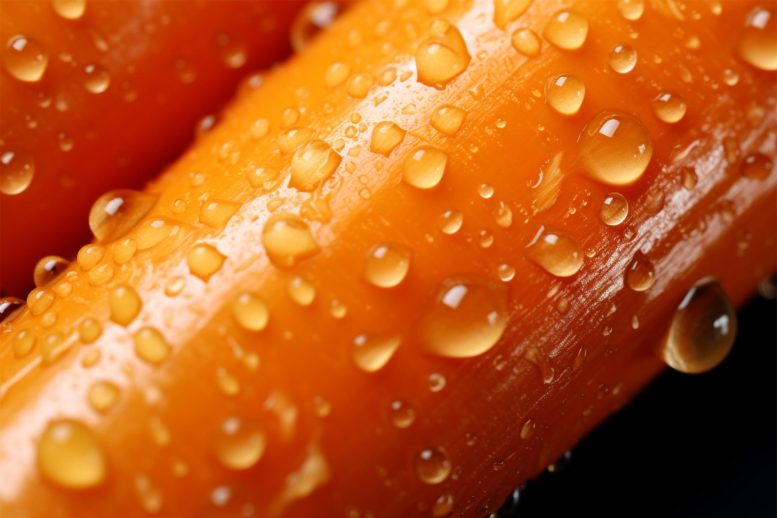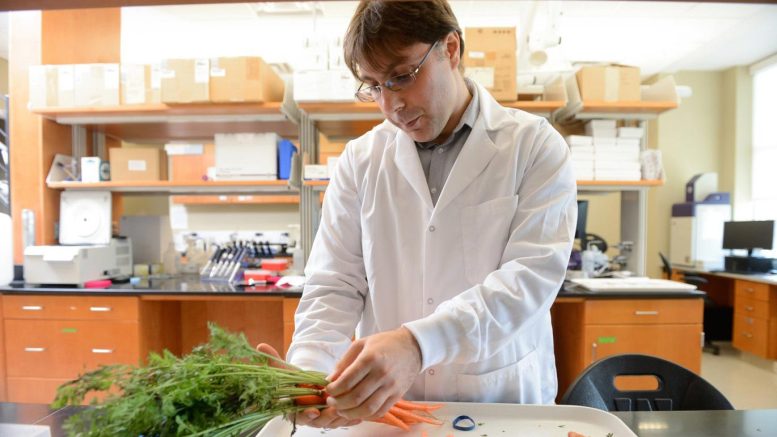
Recent research on 600+ carrot varieties has identified three recessive genes responsible for the orange color. The study provides insights into carrot domestication, its history, and potential health benefits.
Genome study offers answers to questions about pigmentation and domestication.
A new study of the genetic blueprints of more than 600 types of carrot shows that three specific genes are required to give carrots an orange color. Surprisingly, these three required genes all need to be recessive, or turned off. The paper’s findings shed light on the traits important to carrot improvement efforts and could lead to better health benefits from the vegetable.
“Normally, to make some function, you need genes to be turned on,” said Massimo Iorizzo, an associate professor of horticultural science with North Carolina State University’s Plants for Human Health Institute and co-corresponding author of a paper describing the work, published today (September 28) in Nature Plants. “In the case of the orange carrot, the genes that regulate orange carotenoids – the precursor of vitamin A that have been shown to provide health benefits – need to be turned off.”
Nutritional Benefits of Orange Carrots
Carrots, especially orange carrots, contain high quantities of carotenoids, which can help reduce the risk of diseases like eye disease. The orange carrot is the most abundant plant source of pro-vitamin A in the American diet.
NC State researchers worked with colleagues from the University of Wisconsin-Madison to sequence 630 carrot genomes in a continuing examination of the history and domestication of the orange carrot; a 2016 study published in Nature Genetics by these researchers provided the first carrot genome sequence and uncovered the gene involved in the pigmentation of yellow carrot.

Massimo Iorizzo examines orange carrots to learn more about their pigmentation and domestication. Credit: Photo courtesy of Massimo Iorizzo
Selective Sweeps and Domestication
The researchers performed so-called selective sweeps – structural analyses among five different carrot groups to find areas of the genome that are heavily selected in certain groups. They found that many genes involved in flowering were under selection – mostly to delay the flowering process. Flowering causes the taproot, the edible root that we consume, to turn woody and inedible.
“We found many genes involved in flowering regulation that were selected in multiple populations in orange carrot, likely to adapt to different geographic regions,” Iorizzo said.
The study also adds further evidence that carrots were domesticated in the 9th or 10th century in western and central Asia.
“Purple carrots were common in central Asia along with yellow carrots,” Iorizzo said. “Both were brought to Europe, but yellow carrots were more popular, likely due to their taste.”
Orange carrots made their appearance in western Europe in about the 15th or 16th century. The orange carrot may have resulted from crossing a white and yellow carrot, Iorizzo said.
History of the Orange Carrot
“This study basically reconstructed the chronology of when carrot was domesticated and then orange carrot was selected,” he said. “Orange carrot could have resulted from white and yellow carrot crosses, as white and yellow carrots are at the base of the phylogenetic tree for the orange carrot.”
The color and sweeter flavor of the orange carrot drove its popularity and farmers selected for those traits. Different types of orange carrots were developed in northern Europe in the 16th and 17th centuries, which matches the appearance of different shades of orange carrots in paintings from that era. Orange carrots later grew in popularity as greater understanding of alpha- and beta-carotenes, the precursor of vitamin A in the diet, progressed in the late 19th and early 20th centuries.
“Carotenoids got their name because they were first isolated from carrots,” Iorizzo said.
Reference: “Population genomics identifies genetic signatures of carrot domestication and improvement and uncovers the origin of high-carotenoid orange carrots” by Kevin Coe, Hamed Bostan, William Rolling, Sarah Turner-Hissong, Alicja Macko-Podgórni, Douglas Senalik, Su Liu, Romit Seth, Julien Curaba, Molla Fentie Mengist, Dariusz Grzebelus, Allen Van Deynze, Julie Dawson, Shelby Ellison, Philipp Simon and Massimo Iorizzo, 28 September 2023, Nature Plants.
DOI: 10.1038/s41477-023-01526-6
Philipp Simon from the University of Wisconsin-Madison is the paper’s co-corresponding author. Kevin Coe, Hamed Bostan, William Rolling, Sarah Turner-Hissong, Alicja Macko-Podgórni, Douglas Senalik, Su Liu, Romit Seth, Julien Curaba, Molla Fentie Mengist, Dariusz Grzebelus, Allen Van Deynze, Julie Dawson and Shelby Ellison co-authored the paper.
The research was supported by National Institute of Food and Agriculture, U.S. Department of Agriculture (NIFA-USDA), under award numbers 2016-51181-25400, 2022-51181-38321 and Hatch project 1008691.
Abstract: Here an improved carrot reference genome and resequencing of 630 carrot accessions were used to investigate carrot domestication and improvement. The study demonstrated that carrot was domesticated during the Early Middle Ages in the region spanning Western Asia to Central Asia, and orange carrot was selected during the Renaissance period likely in Western Europe. A progressive reduction of genetic diversity accompanied this process. Genes controlling circadian clock/flowering and carotenoid accumulation were under selection during domestication and improvement. Three recessive genes, at the REC, Or and Y2 QTLs, were essential to select for the high alpha- and beta-carotene orange phenotype. All three genes control high alpha- and beta-carotene accumulation through molecular mechanisms that regulate the interaction between the carotenoid biosynthetic pathway, the photosynthetic system and chloroplast biogenesis. Overall, the study elucidated at a molecular level carrot domestication/breeding history and carotenoid genetics.









Be the first to comment on "Orange You Curious? The Surprising Genetic Secrets Behind Carrot Colors"